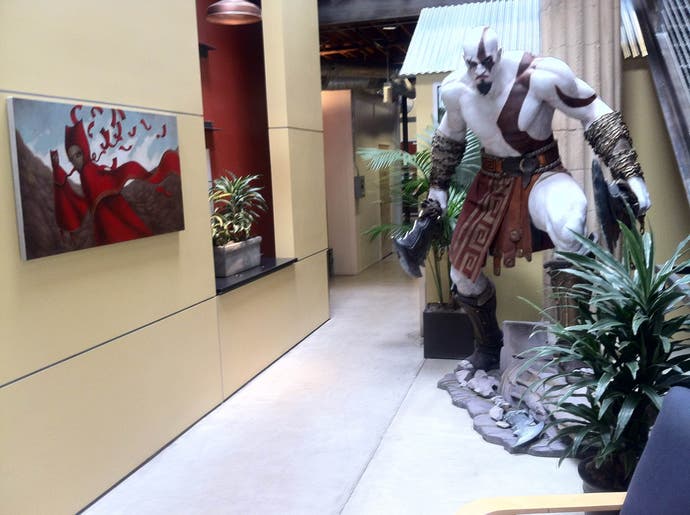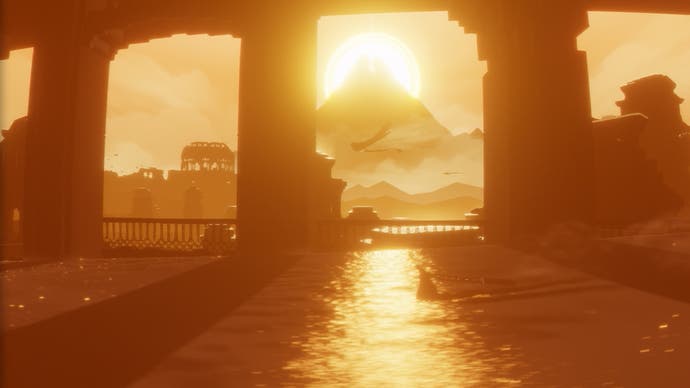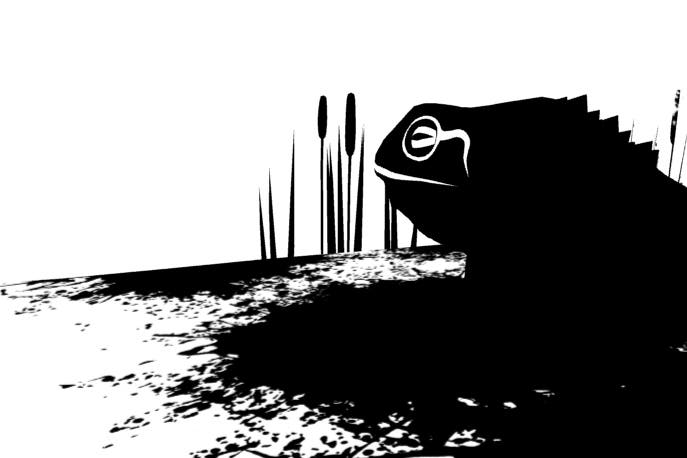Inside Santa Monica Studios, Sony's development commune
It's famed for God of War - but the first party developer is responsible for so much more.
There's no showbiz, and zero spectacle. There never really is inside a development studio, no matter how bombastic the games they produce are - but there's something slightly different about Sony's Santa Monica studio, a small two-storey stretch of red brick tucked away on the outskirts of Los Angeles' Mid-City. For a developer that's built its empire on a foundation of shredded intestines, shattered eyesockets and to the war cries of angry Greek gods, there's an unnerving sense of peace throughout the offices.
A Kratos statue rests calmly in reception, while in one corner there's a miniature Japanese garden that's been scruffily combed over. The silence is only broken when Giant Sparrow's Ian Dallas, the developer behind last year's offbeat wonder The Unfinished Swan, rolls in on his bike and has trouble getting past a receptionist who isn't quite sure who he is, but the contemplative quiet soon returns. This is a developer that's all about contrasts, and it's a contrast that places them at the very heart of Sony's philosophy.
It's a studio born out of the desire to be different. Allan Becker, a highly regarded Sony employee who was working at Sony's Foster City base, wanted to make a break. "They had internal development going on, and I think for him there was this persistent corporate feel to the environment there," explains Shannon Studstill, the current studio director who was around when the studio was formed in 1999.
"He spearheaded plans to find a creative space, and tear away from that corporate atmosphere. He had marketing and finance walking the halls, and when you've got a bunch of creative people that environment doesn't mix well. We ended up landing at Santa Monica, LA, versus downtown San Francisco."

Santa Monica's remit, at first, was to create bold new IP - and after producing Kinetica, a futuristic racing game that helped the studio find its feet, and that established the technology that would become a focal strength of subsequent games, it set about doing that with God of War. The series was, and remains to be, a technical powerhouse that's defined the studio, and earnt it a reputation for creating startling looking games.
But in recent years, Santa Monica's been about much more than Kratos, and about much more than blockbuster games, its credits extending to take in projects as diverse as Twisted Metal, the PixelJunk series and Starhawk, while more recently its incubation programme birthed thatgamecompany's trio of PS3 exclusives, as well as last year's Unfinished Swan. Santa Monica's a studio whose influence can be felt beyond the world of God of War, and it's done more than many other studios in helping define Sony's leftfield gaming philosophy in recent years.
Becker, the man who founded the studio, departed for Japan in 2011, but his philosophy remains a cornerstone for Santa Monica. "When you're working on a game like God of War, you're sort of pigeonholed into third person action games, and that's what you do," explains Santa Monica Studios' Tim Moss. "That's all you do. And Allan Becker, who ran the studio, wanted to do arty games, interesting stuff as well as triple-A super commercial stuff. That's all important, because that makes money - lots of money. But it can be creatively stifling. So that's how we ended up having ThatGameCompany coming in and being an incubated team here.
"The idea was to nurture young teams, and asking how can we exercise our advantage of triple-A for doing this stuff. And that's where it comes in - we can go, someone needs to explain how to do dither patterns to thatgamecompany so they can get rid of their colour grading in Flow. Someone can explain that, and in this really subtle way his game will be better because of the graphics engine of God of War - and no-one ever really needs to understand how that happens. But it will become apparent in the overall quality of the games that one thing led to another."
"Fundamentally, what it comes down to is we try to complement them," adds director of technology Christer Ericson. "We supply from our side a producer to help wrangle things, and the technical know how. And the experience, really. They may have the skill, but until you've made a number of games you don't know what problems you'll encounter. Those sort of things is generally what we come and help with."
The incubation deal is a two-way street, with smaller studios leaning on the expertise, while Santa Monica can feed off the energy of young, creative upstarts. "Jenova Chen's a very inspiring guy to be around," says Moss, before Ericson chimes in to describe a meeting in September 2010 where Chen pleaded for more time to create Journey.
"He was walking through what he wanted to achieve, because their time was effectively up. Traditionally publishers are 'this is how much money you get, this is how much time you get'. Sony's different, and I think that's why we've been here so long. We've been afforded the chance to do the right thing. And in this case, Jenova and his team came to us and said we're not where we want to be with this game, but our time is up and we want an extension to get it where we want it to be. Jenova presented his vision of where he wanted this game to be.

"It was an hour and a half long monologue, and we were like, alright then," adds Moss. "This was the most articulate extension request you've ever seen by a mile."
The three game deal that began with Flow and ended with Journey, and they're three games that are as strong as anything on the PlayStation Network, the kind of offbeat experimentalism that differentiates the PlayStation 3. Was there a temptation to carry on the partnership?
"I think Journey kind of took it out of them," says Moss. "They basically split into two different camps at the end of the project - Jenova and John Edwards are still thatgamecompany. Kelee [Santiago] and Robin [Hunicke] and a few of the other programmers departed. We talked to them about doing something else, but they wanted to do a more expansive project.
"It's art for Jenova, and his definition of art is the more people that see it, the better. And I think that he'd reached a point where it was probably not going to get much better than Journey without being able to expand on mobile and other platforms, and I think they realized they could do that in other ways. It made us pretty sad, but we left on good terms and who knows. We may end up doing something with them again."
For now, though, Santa Monica has a similar deal in place with Unfinished Swan developer Giant Sparrow, and it's one that will hopefully bear more fruit in the future. It's a fascinating set-up, and one that borders on the philanthropic as Santa Monica strives to create a space conductive to making great games, no matter their shape or scope. There's even a slight New Age tinge to the philosophy that creeps it way into Studstill's words. "It's very empowering, and it really speaks to the group that we're not only creating games like God of War," she says. "That kind of happens across everybody here that walks the walls. You're really proud of the little home that you have here for your eight hours of dedicated passion."









